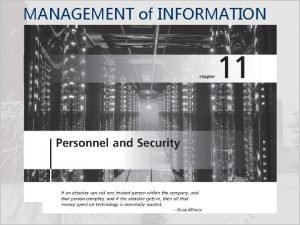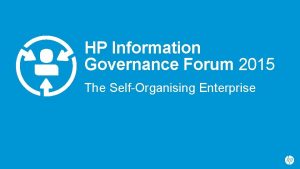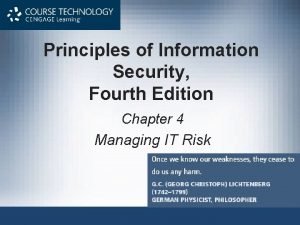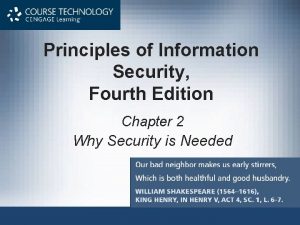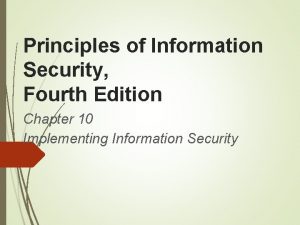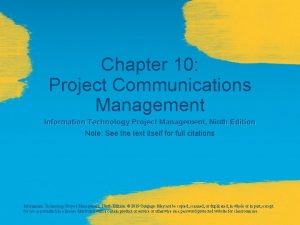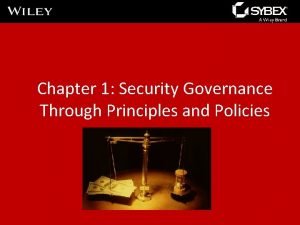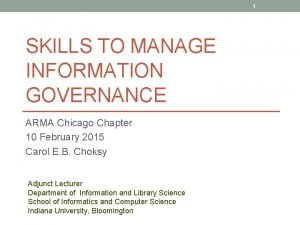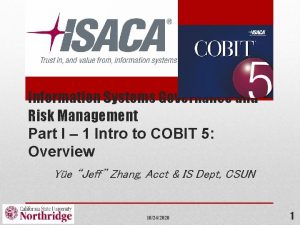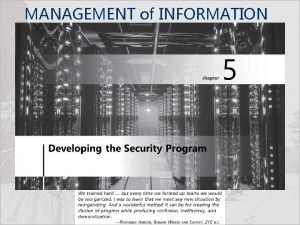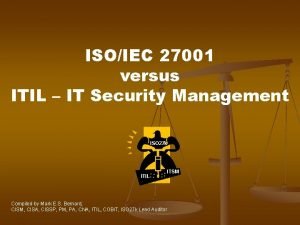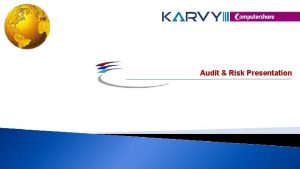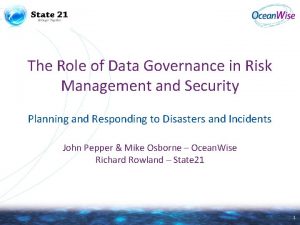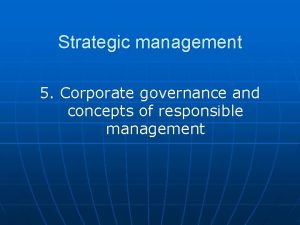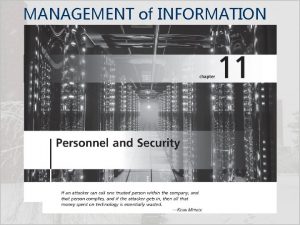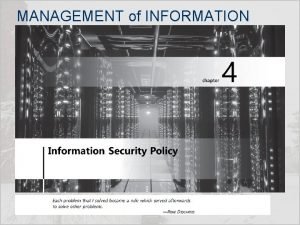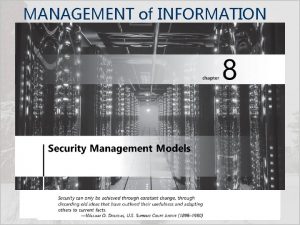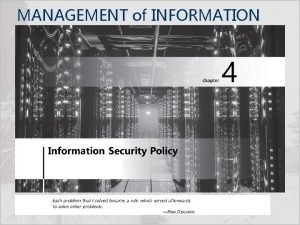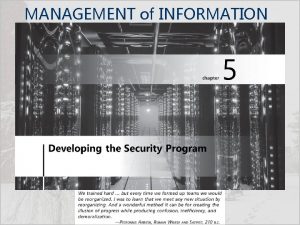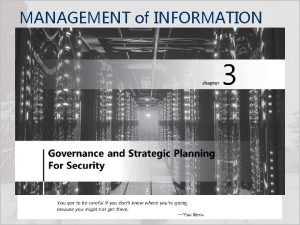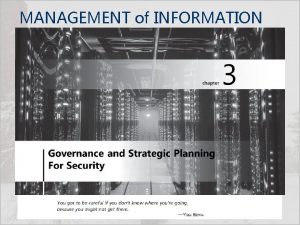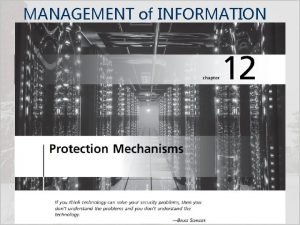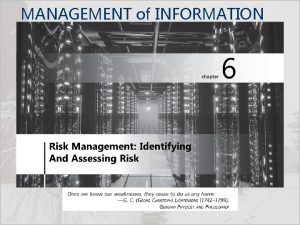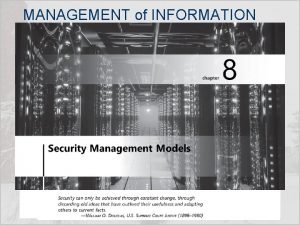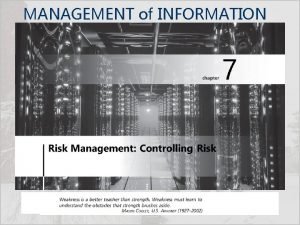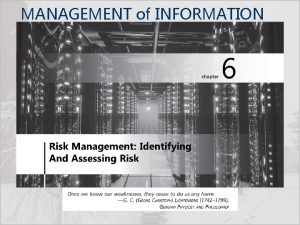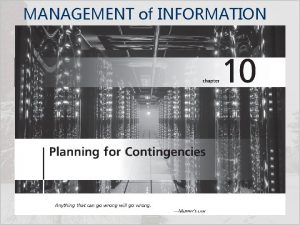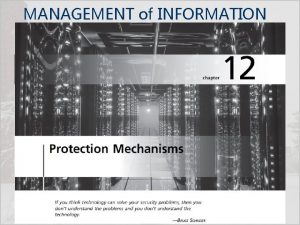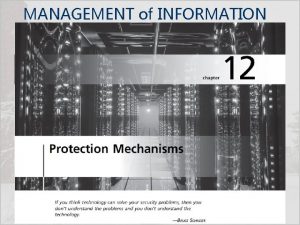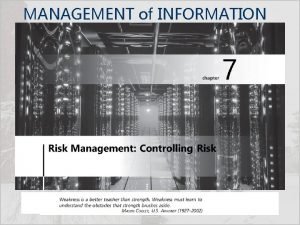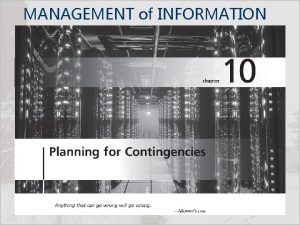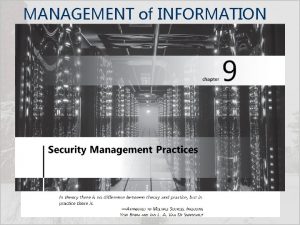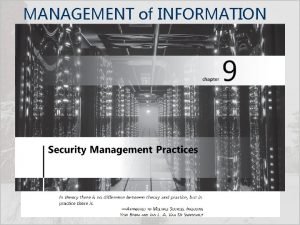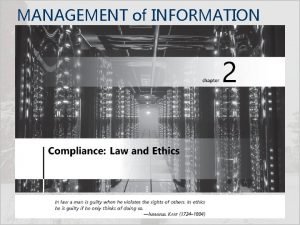MANAGEMENT of INFORMATION SECURITY Fifth Edition Security Governance




































- Slides: 36

MANAGEMENT of INFORMATION SECURITY, Fifth Edition

Security Governance and Planning Management of Information Security, 5 th Edition © Cengage Learning 2

Learning Objectives: • Upon completion of this material, you should be able to: – Identify the roles in organizations that are active in planning – Explain strategic organizational planning for information security (Info. Sec) – Discuss the importance, benefits, and desired outcomes of information security governance and how such a program would be implemented – Explain the principal components of Info. Sec system implementation planning in the organizational planning scheme Management of Information Security, 5 th Edition © Cengage Learning 3

Introduction • It is difficult to overstate how essential planning is. In a setting where there are continual constraints on resources, both human and financial, good planning enables an organization to make the most out of the materials at hand • While a chief information security officer (CISO) and other Info. Sec managers can generate an urgent response to an immediate threat, they are well advised to utilize a portion of their routinely allocated resources toward the long-term viability of the Info. Sec program • However, some organizations spend too much time, money, and human effort on planning with too little return to justify their investment – Each organization must balance the benefits of the chosen degree of planning effort against the costs of the effort Management of Information Security, 5 th Edition © Cengage Learning 4

Introduction (cont. ) • Planning involves: – Representatives of the three communities of interest – Individuals internal and external to the organization • Employees • Management • Outside stakeholders • Among the factors that affect planning are: – the physical environment – the political and legal environment – the competitive environment – the technological environment Management of Information Security, 5 th Edition © Cengage Learning 5

Precursors to Planning • To implement effective planning, an organization’s leaders usually begin from previously developed positions that explicitly state the organization’s ethical, entrepreneurial, and philosophical perspectives • Precursor documents developed to support organizational planning include: – Mission statement – Vision statement – Values statement Management of Information Security, 5 th Edition © Cengage Learning 6

The Mission Statement • A mission statement explicitly declares the business of the organization and its intended areas of operations • The mission statement explains what the organization does and for whom – Random Widget Works designs and manufactures quality widgets and associated equipment and supplies for use in modern business environments Management of Information Security, 5 th Edition © Cengage Learning 7

National Archives’ Mission, Vision and Values Management of Information Security, 5 th Edition © Cengage Learning 8

Values Statement • By establishing a formal set of organizational principles and qualities in a values statement, as well as benchmarks for measuring behavior against these published values, an organization makes its conduct and performance standards clear to its employees and the public – Random Widget Works values commitment, honesty, integrity and social responsibility among its employees, and is committed to providing its services in harmony with its corporate, social, legal and natural environments Management of Information Security, 5 th Edition © Cengage Learning 9

Vision Statement • The vision statement expresses where the organization wants to go, while the mission statement describes how it wants to get there • Taken together, the mission, vision, and values statements provide the philosophical foundation for planning and guide the creation of the strategic plan • Vision statements should be ambitious, as they are meant to express the aspirations of the organization and to serve as a means for visualizing its future – Random Widget Works will be the preferred manufacturer of choice for every business’s widget equipment needs, with an RWW widget in every machine they use Management of Information Security, 5 th Edition © Cengage Learning 10

Strategic Planning • Strategic planning is – “The process of defining and specifying the long-term direction (strategy) to be taken by an organization, and the allocation and acquisition of resources needed to pursue this effort” • It guides organizational efforts and focuses resources toward specific, clearly defined goals in the midst of an ever-changing environment • A clearly directed strategy flows from top to bottom, and a systematic approach is required to translate it into a program that can inform and lead all members of the organization Management of Information Security, 5 th Edition © Cengage Learning 11

Top-down Strategic Planning Management of Information Security, 5 th Edition © Cengage Learning 12

Strategic Planning • First, general strategy is translated into specific strategy; second, overall strategic planning is translated into lower-level tactical and operational planning • Once the organization’s overall strategic plan is translated into strategic goals for each major division or operation, the next step is to translate these strategies into tasks with specific, measurable, achievable, and time-bound objectives Management of Information Security, 5 th Edition © Cengage Learning 13

Strategic Planning • Information Security, like Information Technology, must support more than its immediate parent in the organizational chart • As all organizational units will be using information, and not just IT-based information, the Information Security group must understand support the strategic plans (a. k. a. strategies) of all business units • This role may at times conflict with that of the IT department, as IT’s role is the efficient and effective delivery of information and information resources, while Info. Sec’s role is the protection of all information assets Management of Information Security, 5 th Edition © Cengage Learning 14

Creating a Strategic Plan • After an organization develops a general strategy, it must create an overall strategic plan by extending that general strategy into specific strategic plans for major divisions • Each level of each division translates those objectives into more specific objectives for the level below • The conversion of goals from the strategic level to the next lower level relies on the executive’s ability to know and understand the strategic goals of the entire organization, to know and appreciate the strategic and tactical abilities of each unit within the organization, and to negotiate with peers, superiors, and subordinates Management of Information Security, 5 th Edition © Cengage Learning 15

Planning Levels • Once the organization’s overall strategic plan is translated into strategic goals for each major division or operation, the next step is to translate these strategies into tasks with specific, measurable, achievable, and time-bound objectives • Strategic planning then begins a transformation from general, sweeping statements toward more specific and applied objectives • Strategic plans are used to create tactical plans, which are in turn used to develop operational plans Management of Information Security, 5 th Edition © Cengage Learning 16

Strategic Planning Levels Management of Information Security, 5 th Edition © Cengage Learning 17

Planning Levels • Tactical Planning – has a more short-term focus than strategic planning – usually one to three years – breaks applicable strategic goals into a series of incremental objectives • Operational Planning – used by managers and employees to organize the ongoing, dayto-day performance of tasks – includes clearly identified coordination activities across department boundaries such as: • • communications requirements weekly meetings Summaries progress reports Management of Information Security, 5 th Edition © Cengage Learning 18

Planning and the CISO • The first priority of the CISO and the Info. Sec management team should be the structure of a strategic plan • While each organization may have its own format for the design and distribution of a strategic plan, the fundamental elements of planning are the same for all types of enterprises Management of Information Security, 5 th Edition © Cengage Learning 19

Typical Strategic Plan Elements 1. 2. 3. 4. 5. 6. Executive Summary Mission, Vision and Values Statements Organizational Profile and History Strategic Issues and Core Values Corporate Goals and Objectives Major Business Units (or Products/Services) Goals and Objectives 7. Appendices (as applicable) – market analyses, internal/external surveys, budgets, R&D projections, etc. Management of Information Security, 5 th Edition © Cengage Learning 20

Tips For Planning 1. Articulate a comprehensive and meaningful vision statement that shares the organizations intent, to attract others to join in the effort to achieve that goal 2. Try to bring a sense of logical analysis of the objectives and what has been accomplished; for example, by using tools to track outcomes against intentions to measure effects against prior actions 3. Work from an overarching plan that has been developed with the input from key stakeholders 4. Seek transparency in planning to make planning changes understandable by stakeholders 5. Make planning a process that engages everyone involved to work toward the common objectives Management of Information Security, 5 th Edition © Cengage Learning 21

Tips For Planning (cont. ) 6. Stick with the process over times since results may not always be achieved as quickly as intended 7. Develop consistent and repeatable methods of planning that are adopted as part of the organization’s culture 8. Explain what is being done so that stakeholders understand the intentions of the process 9. Use processes that fit the organization’s culture 10. Make the process as engaging as possible so that participants are not overwhelmed and feel put upon by the required actions Management of Information Security, 5 th Edition © Cengage Learning 22

Information Security Governance • Governance is – “The set of responsibilities and practices exercised by the board and executive management with the goal of providing strategic direction, ensuring that objectives are achieved, ascertaining that risks are managed appropriately, and verifying that the enterprise’s resources are used responsibly” • Strategic planning and corporate responsibility are best accomplished using an approach many call governance, risk management, and compliance (GRC) Management of Information Security, 5 th Edition © Cengage Learning 23

Information Security Governance • The governance of information security is a strategic planning responsibility whose importance has grown in recent years • Information security objectives must be addressed at the highest levels of an organization's management team in order to be effective and offer a sustainable approach Management of Information Security, 5 th Edition © Cengage Learning 24

The ITGI Approach to Information Security Governance • According to the Information Technology Governance Institute (ITGI) information security governance includes all of the accountabilities and methods undertaken by the board of directors and executive management to provide: strategic direction, establishment of objectives, measurement of progress toward those objectives, verification that risk management practices are appropriate and – validation that the organization’s assets are used properly. – – Management of Information Security, 5 th Edition © Cengage Learning 25

The ITGI Approach to Information Security Governance • ITGI recommends that boards of directors supervise strategic Info. Sec objectives by: 1. Creating and promoting a culture that recognizes the criticality of information and Info. Sec to the organization 2. Verifying that management’s investment in Info. Sec is properly aligned with organizational strategies and the organization’s risk environment 3. Mandating and assuring that a comprehensive Info. Sec program is developed and implemented 4. Requiring reports from the various layers of management on the Info. Sec program’s effectiveness and adequacy Management of Information Security, 5 th Edition © Cengage Learning 26

ITGI Information Security Governance Desired Outcomes • Strategic alignment of Info. Sec with business strategy to support organizational objectives • Risk management by executing appropriate measures to manage and mitigate threats to information resources • Resource management by utilizing Info. Sec knowledge and infrastructure efficiently and effectively • Performance measurement by measuring, monitoring, and reporting Info. Sec governance metrics to ensure that organizational objectives are achieved • Value delivery by optimizing Info. Sec investments in support of organizational objectives Management of Information Security, 5 th Edition © Cengage Learning 27

NACD Info. Sec Governance Board of Directors Essential Practices • Place Info. Sec on the board’s agenda. • Identify Info. Sec leaders, hold them accountable, and ensure support for them. • Ensure the effectiveness of the corporation’s Info. Sec policy through review and approval. • Assign Info. Sec to a key committee and ensure adequate support for that committee. Management of Information Security, 5 th Edition © Cengage Learning 28

NCSP Framework for Information Security Governance • According to the Corporate Governance Task Force (CGTF), an advisory group from the National Cyber Security Partnership (NCSP), the organization should engage in a core set of activities suited to its needs to guide the development and implementation of the Info. Sec governance program: – Conduct an annual Info. Sec evaluation, the results of which the CEO should review with staff and then report to the board of directors – Conduct periodic risk assessments of information assets as part of a risk management program – Implement policies and procedures based on risk assessments to secure information assets – Establish a security management structure to assign explicit individual roles, responsibilities, authority, and accountability Management of Information Security, 5 th Edition © Cengage Learning 29

NCSP Framework for Information Security Governance (cont. ) – Develop plans and initiate actions to provide adequate Info. Sec for networks, facilities, systems, and information – Treat Info. Sec as an integral part of the system life cycle – Provide Info. Sec awareness, training, and education to personnel – Conduct periodic testing and evaluation of the effectiveness of Info. Sec policies and procedures – Create and execute a plan for remedial action to address any Info. Sec deficiencies – Develop and implement incident response procedures – Establish plans, procedures, and tests to provide continuity of operations – Use security best practices guidance, such as the ISO 27000 series, to measure Info. Sec performance Management of Information Security, 5 th Edition © Cengage Learning 30

CGTF General Governance Framework Management of Information Security, 5 th Edition © Cengage Learning 31

Info. Sec Governance Responsibilities Management of Information Security, 5 th Edition © Cengage Learning 32

CERT Governing for Enterprise Security Implementation • In 2007, the CERT Division of Carnegie Mellon University’s Software Engineering Institute (CMU/SEI) published and promoted an implementation guide for its trademarked Governing for Enterprise Security (GES) program, now outdated but still useful • The GES includes three supporting Articles: – Article 1: Characteristics of Effective Security Governance – Article 2: Defining an Effective Enterprise Security Program – Article 3: Enterprise Security Governance Activities Management of Information Security, 5 th Edition © Cengage Learning 33

CERT GES Hierarchy Management of Information Security, 5 th Edition © Cengage Learning 34

ISO/IEC 27014: Governance of Information Security • ISO 27014: 2013 is the ISO 27000 series standard for Governance of Information Security • The standard specifies six high-level “action-oriented” information security governance principles: 1. 2. 3. 4. Establish organization-wide information security Adopt a risk-based approach Set the direction of investment decisions Ensure conformance with internal and external requirements 5. Foster a security-positive environment 6. Review performance in relation to business outcomes Management of Information Security, 5 th Edition © Cengage Learning 35

ISO/IEC 27014: Governance of Information Security Management of Information Security, 5 th Edition © Cengage Learning 36
 Management of information security 5th edition
Management of information security 5th edition Principles of marketing fifth european edition
Principles of marketing fifth european edition Lazarus cognitive appraisal theory
Lazarus cognitive appraisal theory Fundamentals of corporate finance fifth edition
Fundamentals of corporate finance fifth edition Fifth edition chemistry a molecular approach
Fifth edition chemistry a molecular approach Segregat
Segregat Molecular biology
Molecular biology Human anatomy fifth edition
Human anatomy fifth edition Human anatomy fifth edition
Human anatomy fifth edition Hpe information management and governance
Hpe information management and governance Failure of supporting utilities and structural collapse
Failure of supporting utilities and structural collapse Principles of management information system
Principles of management information system Concentration risk
Concentration risk 12 principles of information security
12 principles of information security Principles of information security 4th edition
Principles of information security 4th edition Information technology project management 9th edition
Information technology project management 9th edition Information technology project management 9th edition ppt
Information technology project management 9th edition ppt Vertical
Vertical Information technology project management 8th edition
Information technology project management 8th edition Information technology project management 9th edition
Information technology project management 9th edition Introduction to management information systems 5th edition
Introduction to management information systems 5th edition Management information systems 13th edition
Management information systems 13th edition Information technology project management 9th edition
Information technology project management 9th edition Mis chapter 6
Mis chapter 6 Using mis (10th edition)
Using mis (10th edition) Private securty
Private securty Visa international security model in information security
Visa international security model in information security Cnss model 27 cells example
Cnss model 27 cells example Security governance principles
Security governance principles Arma dacum
Arma dacum 5 domains of it governance
5 domains of it governance Chapter 9 information management and security
Chapter 9 information management and security Project management for information security
Project management for information security Iso vs itil
Iso vs itil Information security management
Information security management Data governance and risk management
Data governance and risk management Corporate governance in strategic management
Corporate governance in strategic management
